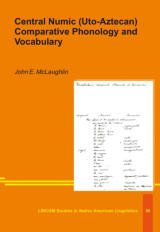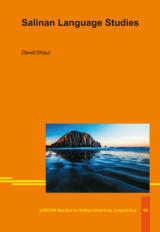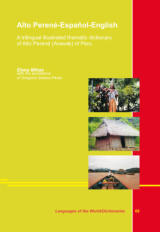
academic publishers
LINCOM GmbH, Hansjakobstr. 127a, D-81825 München, Allemagne
FAX+49 89 62269404, TEL +49 89 3149593, contact@lincom.eu











NATIVE AMERICAN LANGUAGES
Central Numic (Uto-Aztecan) Comparative Phonology and Vocabulary John E. McLaughlin Utah State University The Central Numic branch of the Numic language family of the Uto-Aztecan stock comprises three closely-related languages—Timbisha, Shoshoni, and Comanche. Timbisha and Comanche are spoken by less than a handful of L1 speakers each in eastern California and southwestern Oklahoma. Shoshoni is spoken by fewer than a dozen L1 speakers scattered across Nevada, Utah, Idaho, and Wyoming. All three languages are still spoken in parts of the regions where they lived at the time of contact. A very rough estimate of the time depth of Proto-Central Numic is about a millennium. Timbisha and Shoshoni have an underlying obstruent system which consists of voiceless stops /p, t, k, kw/, two voiceless fricatives /s, h/, and a voiceless affricate /ts/, but a surface phonetic system that includes voiced and voiceless stops, fricatives, and affricates in all the places of articulation of the underlying stops and affricates. This system of underlying and surface obstruents has been partially restructured in Comanche. John E. McLaughlin, Associate Professor of English at Utah State University, has published on the Central Numic languages since 1980. ISBN 9783969391488. LINCOM Studies in Native American Linguistics 86. 66pp. 2023. Salinan Language Studies David Shaul University of Arizona Salinan (coastal central California) is not only abundantly attested in modern recordings after 1900, but also is the only native California language to have been richly documented by the Franciscans in the 1800s. This work contains a summary of the sound pattern, and the most complete morphosyntax description of the language. Data is from both dialects (Antoniano, Migueleño), but is mostly Antoniano. Of particular interest is the revelation of a pitch-accent system (two melodies), accounting for "stress" irregularity. The remarkable variety of plural forms is explained by a process of derivation that depends on the melody inherent in a given root. Pluractionality in verbs is shown to be rare, especially in data recorded after 1900. A specifier serves as only productive adposition, and also is used in marking relative clauses and in person possessor marking on nouns. The stative-active resolution of Salinan verbs is explored through occurences of each category in texts. Sample texts, some never published, show the discourse strategy of Salinan. A summary is given of Salinan linguistic prehistory with application of Hokan Common Core. The Salinan and Engish Lexicon is a companion volume. ISBN 9783862902132 (Hardbound). LINCOM Studies in Native American Linguistics 85. 322pp. 2020. Alto Perené-Español-English A trilingual illustrated thematic dictionary of Alto Perené (Arawak) of Peru Elena Mihas James Cook University with the assistance of Gregorio Santos Pérez Alto Perené speakers reside in the foothills of the eastern Andes and the western fringe of the Amazonian jungle of Peru. The highly endangered language is spoken by about three hundred people. There are a few hundred more people with varying degrees of proficiency in the language. This trilingual dictionary is a result of eight years of the author’s fieldwork in the Native community located in Chanchamayo Province of Peru. The dictionary is produced in close collaboration with fifty native speakers. It collects and preserves the most critical culture-specific information about the community’s traditional ways of living. The introductory prefaces in Spanish and English present a brief linguistic profile of the language. The dictionary provides glossaries in English and Spanish and links to online materials. It contains over 900 entries which are amply illustrated by natural language data from field recordings, and by numerous drawings and photographs. The readership includes Alto Perené learners, bilingual teachers, linguists and anthropologists. ISBN 9783862888474 (Hardbound). Languages of the World/Dictionaries 68. 194pp. ca. 120 photographs and drawings. 2017.














